Overcoming language barriers with choral music
The EchangeChœurs exchange program brings Swiss children's and youth choirs together across language barriers. It is jointly launched by the Sophie and Karl Binding Foundation, Movetia, the National Agency for Exchange and Mobility and the Swiss Children's and Youth Choir Promotion Association SKJF.
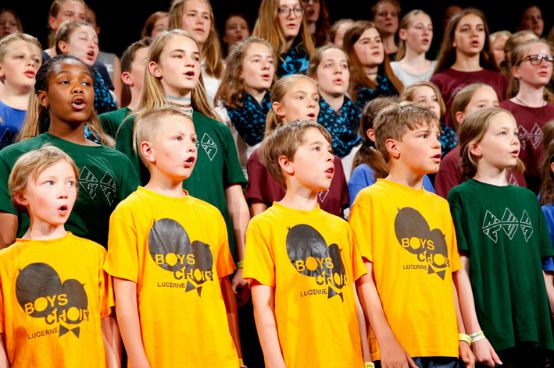
Switzerland's cohesion across language borders cannot be taken for granted. The recent debates on foreign language teaching in some cantons show that communication across linguistic borders is always in need of new impetus.
The new exchange and support program EchangeChœurs enables children's and youth choirs from French-speaking and German-speaking Switzerland, for example, to find a partner choir in another language region. Exchange projects with choirs from Italian- or Romansh-speaking Switzerland are also supported. Movetia provides an online exchange platform for finding partners. The two choirs that have found each other then plan a joint concert (or several concerts).
The financial support per exchange project depends on the number of participants and ranges from 3,000 to 7,000 francs. EchangeChoeurs also offers tips on organizing the choir exchange and other assistance, such as a list of phrases in two languages such as "Faites attention à l'intonation"/"Mind the intonation".
Choirs are particularly suitable for language and cultural exchange because choral singing combines language and music as an art form. With a jointly developed program and concert, the participating children and young people can not only practice their language skills, but also get to know another choir and its musical profile. The joint expression of musical emotions has a unifying effect.
The three project partners complement each other perfectly to implement the project. The Sophie and Karl Binding Foundation, for which the cohesion of the language regions is a central funding theme, is responsible for financing the projects and the funding program as a whole and provides the project management. The SKJF association provides its network in the children's and youth choir scene as well as its expertise in terms of content, and Movetia, which also implements a "class exchange program" for the federal government, is responsible for matching the choirs and the initial assessment of the applications. An advisory board with experienced experts in youth choral music from all parts of the country supports the project.
Links
Canton Schwyz shifts cultural burden equalization
The voters of the Canton of Schwyz have decided that from 2022, the canton's contributions to cultural institutions in Lucerne and Zurich will no longer be covered by the regular budget, but will instead be paid from the lottery fund.
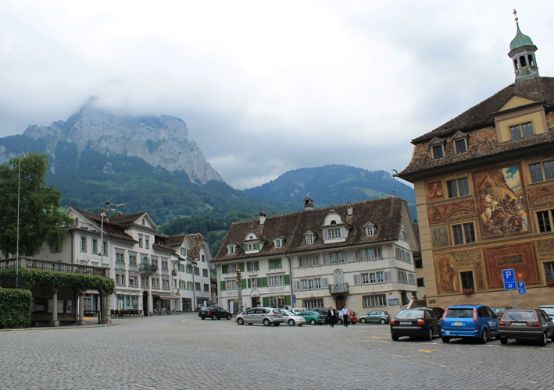
The termination of the agreement on intercantonal cooperation in the area of supra-regional cultural institutions was approved by a vote of 26,926 in favor (55.88%) to 21,258 against (44.12%). The municipalities of Feusisberg, Wollerau and Freienbach, which are most strongly oriented towards Zurich, achieved the highest approval rates of over 60 percent. The bill was rejected in the municipalities of Schwyz and Innerthal.
As part of a relief program, the cantonal government has presented the cantonal council with a package of measures consisting of task waivers, service reductions and burden shifts. One of the measures: in future, services in the area of cultural burden equalization should be paid from the lottery fund instead of the general state budget. To make this possible, the Council applied to withdraw from the cultural burden agreement at the next ordinary termination date at the end of 2021.
With the termination of the cultural burdens agreement, the canton's legal obligation to financially compensate for supra-regional cultural burdens no longer applies. It can therefore relieve its income statement to the tune of around CHF 1.8 million a year. However, cultural professionals fear that this will mean that less money will be available for cantonal cultural promotion from the lottery fund.
The music critic between producer and consumer
A project by the Swiss National Science Foundation, the Lucerne School of Music and the University of Sheffield is investigating the role of music criticism in the classical music market. A survey is being conducted for this purpose and will be online until the end of the year.

In the project description on the website of the Lucerne School of Music, the study is presented as follows: "Reviews of music recordings and performances are published daily in the daily press as well as on the Internet. A central function of such reviews is to offer the consumer a kind of orientation aid. (...) The present project (...) examines the function of criticism in the classical music market from the perspective of critics and consumers and determines the characteristics of music criticism that most influence consumer and purchasing behavior. Interviews and experiments as well as questionnaires and qualitative text analysis are used in the study." The project manager is Elena Alessandri. It is expected that the project will "provide a deeper understanding of the psychologically motivated behaviors of consumers caused by music criticism". "This understanding forms the basis for a more targeted and effective approach to music criticism, especially with regard to the lack of orientation caused by a music market that is almost impossible to navigate today."
Part of the project is a survey of people who enjoy listening to classical music. The survey will be conducted online and will be available here until the end of the year:
Link to the survey
Grand Prix Music 2017 for Patricia Kopatchinskaja
The Swiss Grand Prix Music 2017 goes to violinist Patricia Kopatchinskaja. The award ceremony took place this Friday at the Kaserne Basel. The musician, who is currently playing at the prestigious Enescu Festival, spoke about her award during a live broadcast from Bucharest.
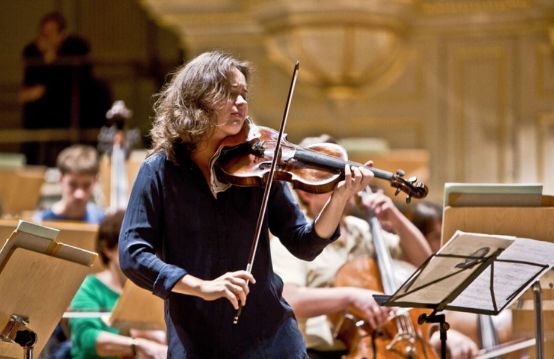
Patricia Kopatchinskaja has been selected from 15 prizewinners on the recommendation of the Federal Jury for Music and will receive prize money of 100,000 Swiss francs.
The Federal Office of Culture FOC has awarded the Swiss Grand Prix Music for the fourth time. The award recognizes "the outstanding and innovative musical work of individual musicians or groups". Once again this year, the 15 prizewinners represent the entire spectrum of Swiss musical creation.
The fifteen winners of the 2017 Swiss Music Awards are Pascal Auberson (Lausanne), Andres Bosshard (Zurich), Albin Brun (Lucerne), Christophe Calpini (Longirod), Elina Duni (Zurich), Vera Kappeler (Halbenstein), Jürg Kienberger (Basel), Grégoire Maret (New York), Jojo Mayer (New York), Peter Scherer (Zurich), Endo Anaconda (Fankhaus-Trub), Töbi Tobler (Wittenbach), Helena Winkelman (Basel), Jürg Wyttenbach (Basel) and Patricia Kopatchinskaja (Bern), who receives the Swiss Grand Prix for Music.
Landis & Gyr Foundation promotes intercultural projects
The Landis & Gyr Foundation has an additional new funding focus: it now supports cultural and artistic projects in Switzerland that deal with the discussion and integration of people from foreign cultures.

This refers to projects "that strengthen the coexistence of people from different cultures in Switzerland and thus have a positive influence on social cohesion". The interactive, participatory element or the aspect of mediation must play an important role here. The project must be linked to an institution (e.g. an association, a cultural institution or a cultural event organizer).
Applications can be submitted immediately and at any time. The following documents must be submitted: Cover letter with coordinates of the applicant, brief summary of the project, detailed project description, information on the parties involved, budget with financing plan,
Applications should be sent by post to:
Landis & Gyr Foundation P.O. Box 7838 CH-6302 Zug
If you have any questions: Phone 041 724 23 12 or mail to regula.koch@lg-stiftung.ch
Composing for the performers next door
Künstlerhaus Boswil is promoting networking with the recently launched Academy for New Music. "What's now?" is the name of the first project.
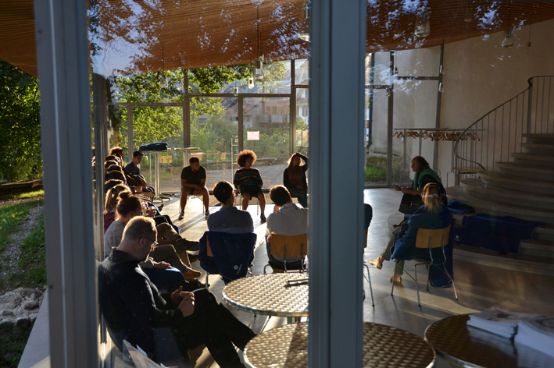
Two concerts in Boswil and Zurich at the beginning of September marked the start of the realignment of the Ensembles Boswil given. The ensemble, which has been in existence since 2007, is made up of around twenty students from various music academies in Switzerland. Works by the established composers Hindemith, Cage and Varèse were combined with contemporary pieces by Isabel Mundry and Philippe Kocher. Certainly not an overly spectacular concert program if there wasn't a long-term idea with potential behind it.
The starting point was to intensify cooperation with Swiss music academies: In addition to the further training of highly talented performers in contemporary music, young female composers should also be integrated into the project. Thus, an academy was launched, which was to be supported by the project What's now? was launched. "This networking of composers and young performers in the form of simultaneous masterclasses is, so to speak, the core idea of the academy," explains project manager Stefanie C. Braun.
-
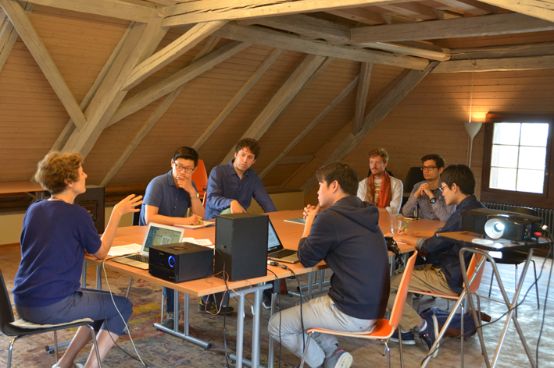
Master class with Isabel Mundry. Photo: Künstlerhaus Boswil
A master class in composition was therefore also held as part of the rehearsals for the Boswil ensemble's September concert. Both events were held in collaboration with the Zurich University of the Arts (ZHdK). The selection process was differentiated, as Braun explains: "The composers applied to us with their CV and samples of their work in response to a call for applications from the Künstlerhaus or the Academy. The work samples included the scores as well as audio and video material of the works."
The director of the master class, Isabel Mundry, Felix Baumann from the ZHdK, Michael Schneider, the managing director of the Künstlerhaus, and Stefanie Braun reviewed the work samples together and then invited six participants to Boswil based on their suitability, technique, training, experience and artistic expressiveness: In contrast to courses for instrumentalists, "who are all still university students, the Academy for New Music is aimed at composers after or in their Masters".
As part of the master class in composition, there was a lively exchange with the performers present, who rehearsed the aforementioned concert program in parallel under the direction of the accomplished, internationally renowned conductor Peter Tilling. The concerts in Boswil and Zurich were well attended.
A second rehearsal phase will then follow in January 2018, during which the new works that the six composers have created in the meantime will be rehearsed and performed. An impressive concept, the support of which is secured by a three-year contract with the Ernst von Siemens Music Foundation Zug/Munich. According to Stefanie Braun, negotiations are already underway with the universities of Lausanne and Basel for the next two editions of the academy.
-
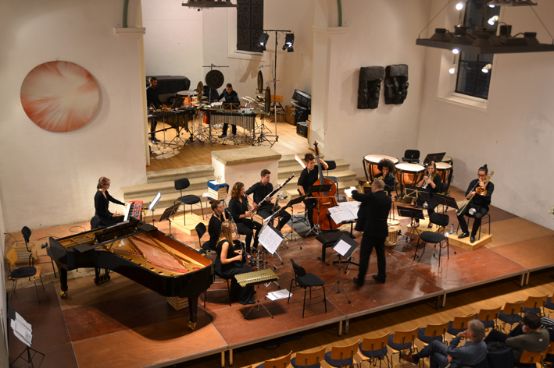
Concert on September 7, 2017 in the old church in Boswil. Photo: Künstlerhaus Boswil
German platform for integration work
The German Music Information Center (MIZ) provides a platform for those involved in musical integration activities in Germany. Those involved in musical integration work are invited and encouraged to participate in the service.
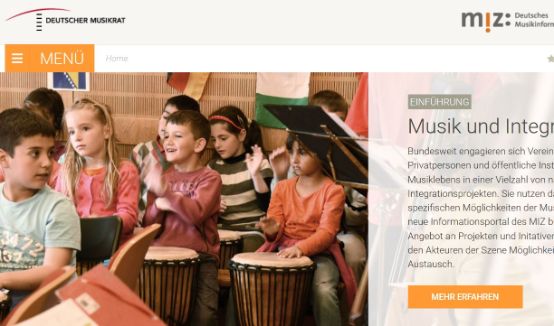
A project database forms the first milestone of the new information and exchange portal "Music and Integration", which presents the entire range of initiatives, projects and events relating to the topic. The aim is to intensify the exchange of experience and communication between stakeholders and organizers of music-related integration projects and thus strengthen the diversity and quality of the measures on offer.
To this end, the platform will be successively expanded until spring 2018 with a central forum for exchange and a wide range of thematic information, including introductory articles as well as work aids and practical materials.
The MIZ can build on its experience with the platform "Musik macht Heimat - Engagement für Dialog", which was launched in October 2015. It was created in response to the diverse and often impromptu aid projects for refugees and made the commitment of associations, private individuals and public institutions in the music sector visible for the first time.
More info: integration.miz.org
Audio streaming increasingly important worldwide
According to a recent IFPI report, copyright infringements remain a key challenge for the music industry worldwide: 40 percent of consumers listen to music via unlicensed services. This group also includes the 35 percent of Internet users who use so-called stream rippers.

According to the Music Consumer Insight Report 2017 "Connecting with Music" by the International Federation of the Phonographic Industry (IFPI), more than one in two (53%) 16 to 24-year-olds worldwide already "rip" music. Germany is below the global average in these areas: here, 30% of users obtain musical content from unlicensed sources and a total of 26% use stream rippers.
According to the report, 13 to 15-year-olds have an intensive relationship with music: despite the large number of competing media, 85% of them stream music, 79% via video streaming services and 67% via audio streaming services, an increase of 13 percentage points compared to the previous year. Of the young audio streamers, 37% are subscribers to paid services, while 62% stream ad-supported music.
User-upload video services such as YouTube have the largest share of on-demand streaming time, but do not give creators and their partners a fair share of the revenue, writes the IFPI. Yet 85 percent of YouTube visitors now use the site to listen to music every month, 76 percent of them even stream music they already know.
Fortuna turns the wheel
The children's and youth choirs of the Basel Music School presented a choral opera by Beat Vögele as part of the Music Academy's anniversary celebrations.
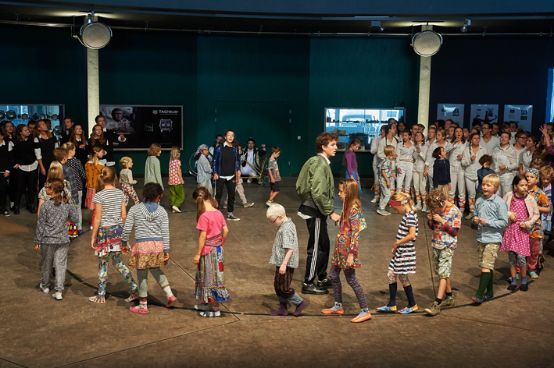
On the weekend of September 16/17, many wheels and circles turned in the round of the "Pantheon" in Muttenz, in this unadorned industrial building from the 1960s in no man's land between the highway junction, railroad and residential area. Ten years ago, the mighty round hall was renovated and converted into a classic car museum. Since then, the venue and restaurant have been increasingly booked for events.
The location proved to be ideal for the performances of the youth choir opera in several respects The big turn. There was no need for a backdrop - and not just for reasons of economy - as the theme of "turning" was impressively illustrated both by the omnipresent wheels of the vintage cars and the shape of the building. When the goddess Fortuna then also did her rounds on the tandem, on the wheel and on the lid of the drinking bottle and the performers marched forwards or backwards in a circle, depending on the turn of the play, the symbolism was complete.
Everything has its time
Lukas Holliger's libretto essentially consists of four life stories whose protagonists, for various reasons, want to turn back the clock, but then come to the realization that this is not possible in real life, nor is it desirable. The author has succeeded in creating a straightforward, simple yet profound examination of one of the great human issues that not only children and young people are concerned with: How can we accept what is unchangeable, learn lessons for our present lives and look to the future. Beat Vögele's music supports this search for meaning excellently with its colorfulness and drama. The complex score was competently interpreted by an outstanding chamber orchestra consisting of teachers from the Music Academy. Five choirs from the Basel Music School, graded according to age, had far more to do than simply sing beautifully. From announcing impending doom to symbolizing the course of time to choreographed, active acting, the young performers had many functions to fulfil. At the same time, the demanding music had to be mastered by the singers. This was especially true for the young soloists. The scene with bank manager Quentin's nightmares was particularly gripping: Quentin will later regret having turned back the clock, as he is confronted with dark spots in his past that he would rather not be reminded of. "Forwards they are sad, backwards they are sad", the saying goes.
At the end, the "deus ex machina" appears in the person of the devil and gives the play a saving twist. Fortuna is distracted and the tandem is turned in the opposite direction, so that the goddess of fate drives into the future again without realizing it. The chorus intones "Everything has its time" and reminds us that once missed, it is almost impossible to make up for it.
Singing has a tradition
The choir at the Basel Music School is a model of success that is second to none. Susanne Würmli-Kollhopp started with the first children's choir at the Riehen Music School around 1980. From 1983, she continued and expanded her choral work at the Basel Music School. Maria Laschinger, who has been team-teaching the choirs together with Regina Hui, Beat Vögele and Christa Andres since 2010, once went through the choir school herself. She sang under Susanne Würmli for 30 years and was finally elected as her successor in 2007. The social and intergenerational aspects of her work are very important to the management team. Families" were formed from the 180 participants: one to three children from each of the five choirs. This created a welcome exchange and cohesion in which the older members were able to look after the younger ones.
There is no need to worry about new blood in Basel. Young people who enjoy singing sign up on their own and don't need to be sought out.
On Saturday, September 23, one of the choirs will sing in the world premiere of a work by Argentinian composer Guillermo Klein at the Musik-Akademie ceremony in St. Martin's Church. The European Youth Choir Festival 2018 in Basel is set to be another highlight and the Midsummer Choir Festival in Margarethenpark is on the program in June 2018.
-
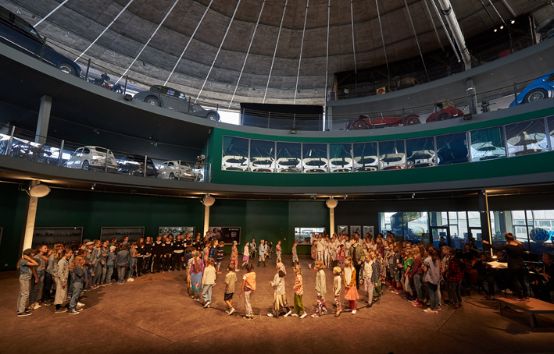
Photo: Werner Laschinger
Music changes our perception of touch
Scientists at the Max Planck Institute for Human Cognitive and Brain Sciences (MPI CBS) in Leipzig have discovered that we perceive touch differently depending on what music is being played at the time.
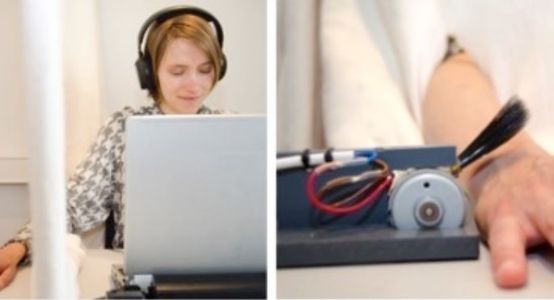
"We have observed that the more beguiling the music we hear, the more seductive we experience touch," explains study leader Tom Fritz. The neuroscientists came to this conclusion with the help of incognito touch. They had study participants stretch their forearm through a curtain and stroke it behind it with a precisely controlled movement using a brush robot. At the same time, the participants listened to various pieces of music, which they then rated themselves on a scale ranging from "not sexy at all" to "extremely sexy".
The interesting thing is that even when the test subjects learned before the experiment that they were not being stroked by a real person but by a robot, the music influenced how sexy the touch was perceived. This robot, an automatically controlled brush, was designed to control the length and intensity of the touch. At the same time, its use also showed that the observed so-called transfer effects of music on touch must be based on very basic mechanisms - and not on the idea of being touched by a person of a certain gender and attractiveness level listening to the same seductive music.
One possible explanation could be that the emotional expression of individual musical sounds follows the same dynamic as that of a touch. A sad sound is therefore processed in a similar way to a sad touch in terms of its rhythm, and an aggressive sound in the same way as an aggressive touch. Accordingly, we access areas of the brain that are responsible for both touch and movement in order to process music more precisely.
Such transfer effects, in which sensory perceptions change depending on the music we are listening to, have also been observed in other areas. For example, the louder the music we are listening to, the richer and brighter the colors we choose.
Subsidies 2017 from the canton of Zug
The Government Council of the Canton of Zug has awarded grants of between CHF 10,000 and CHF 14,000 to four musicians. The Zuger Werkjahr, endowed with 50,000 francs, goes to the freelance theater director Karin Arnold.
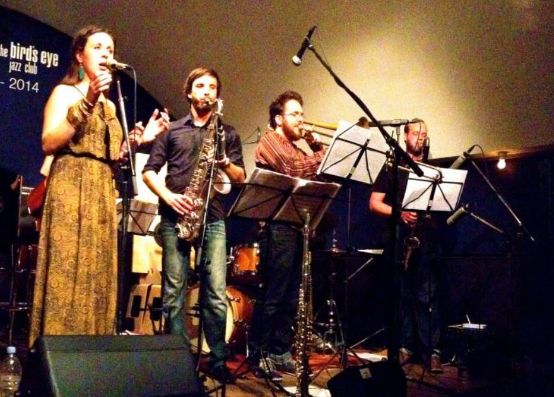
Twenty-three applications for a grant and six applications for a Zug Work Year were received in 2017, writes the Canton of Zug. The grants in the music category went to Fabienne Ambühl and Samuel Büttiker (CHF 14,000 each) and Valerie Koloszár and Christof Zurbuchen (CHF 10,000).
CHF 120,000 is available, which can be used for independent artistic creation, the realization of a specific project or as a contribution to further education. The grants and the work year are financed from the lottery fund.
The Zug Work Year, endowed with 50,000 Swiss francs, goes to theater artist Karin Arnold. Karin Arnold was born in 1974 and lived in Zug until 1995. She completed her artistic training at the Hochschule Musik und Theater in Zurich (now Zurich University of the Arts). She has been working as a freelance director since 2006 and founded the "mercimax" collective in the same year.
Showing what "music" is
On September 23, the Music Academy celebrates its big anniversary with over 100 concerts on various stages, including the newly renovated Great Hall.
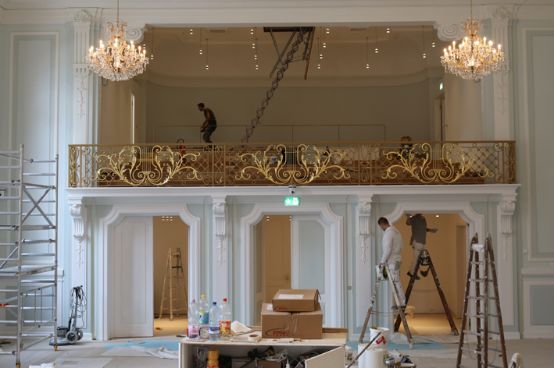
Painting, drilling and fine-tuning are still taking place in the Great Hall of the Basel Music Academy. But everything is actually ready for the Jour de Fête on September 23. The history of today's music campus, which provides space for musical education in its most diverse forms on Leonhardsgraben in the heart of the city, began 150 years ago with the founding of the music school. This long history is documented in the commemorative publication Sound art goes to schooland the exhibition Avant-garde goes to school makes it visible and audible.
Around 1000 musicians will take part in 100 events on various stages on the festival day on September 23. As Stephan Schmidt, Director of Musik-Akademie Basel/Musikhochschulen FHNW, and Anna Brugnoni, Head of Musikschule Basel, explained at today's press conference, the aim is to show what "music" is and to provide an insight into the work that needs to be done in order to preserve music as a distinct form of thinking and feeling in the future. Basel's patrons and foundations are aware of the importance of this work - think of the Jazzcampus or the Vera Oeri Library, for example - and so, thanks to the generous support of Sabine Duschmalé-Oeri, the large hall will also be completed on time. On the one hand, it will be preserved as a historical gem, as the preservation order has accompanied the conversion process. On the other hand, state-of-the-art technology ensures that it can be used intensively and in a variety of ways - for the first time at the Jour de Fête.
Information on
Exhibition
Avant-garde goes to school. Exhibition, curated by Corinne Holtz, for the 150th anniversary of the Basel Music Academy, Vera Oeri Library, September 14 to December 23, 2017
Link to the program of the Jour de Fête, the big party at the Musik-Akademie BaselInformation on further highlights and commissioned compositions can be found on pages 42 and 43 of the program booklet.
Biel's cultural delegate has left the city
After 15 years of service, Eszter Gyarmathy, the City of Biel's Delegate for Culture, has decided to take on new challenges. By agreement, she ended her position on September 1, 2017.
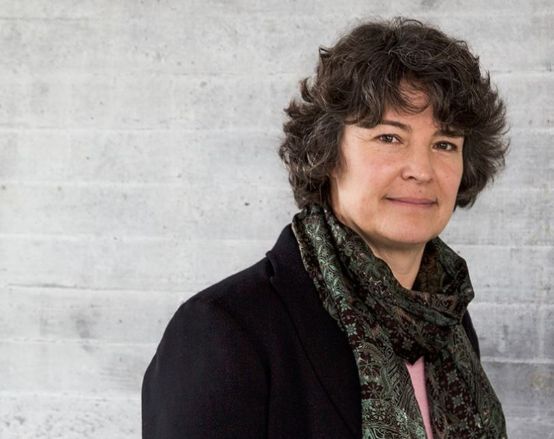
According to the press release from the City of Biel, the City of Biel and the cultural scene will express their gratitude to her at the Culture Award ceremony on November 28, 2017.
The Biel/Bienne Department of Culture fulfills coordination, information, administrative and cultural policy tasks and manages a budget of around 11 million francs. Around 30 cultural foundations and associations receive annual subsidies. Numerous events and the creation of works are supported on a selective basis. It looks after the city's collections of art and cultural assets. Since 1986, the Department of Culture has also been responsible for two cultural venues: the Alte Krone and the Kulturfabrik Gurzelen.
Classical music on a platter
Classical:NEXT is looking for showcases, conference contributions and project presentations for the next edition in May 2018. The deadline for submissions is Friday, September 29, 2017.
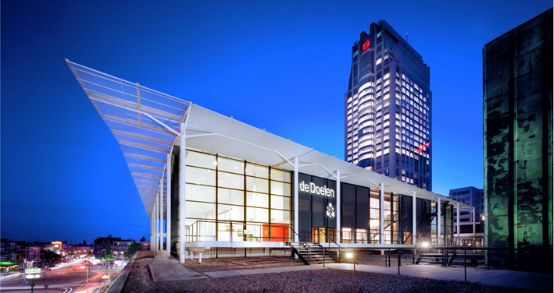
The Classical:NEXT is a forum for artists and professionals from various fields of classical and contemporary music. From event organizers and festivals to publishers, labels and associations to agencies and music creators: 1200 music professionals from 45 countries took part in the sixth edition last May (see short report in the Schweizer Musikzeitung). Next year's seventh Classical:NEXT in Rotterdam will once again offer the opportunity to expand your own international network. It will also feature an extensive program with showcases, conferences and project presentations. The tendering process is currently underway:
Deadline for submissions is Friday, September 29, 2017.
Musicians can apply with their stage projects for a showcase performance, and speakers can propose their ideas for conference contributions and project presentations to a jury. Those selected will be given the opportunity to present themselves to a large, international audience of experts at Classical:NEXT 2018.
Classical:NEXT will take place at Congress Center de Doelen, Rotterdam (NL), from 16 to 19 May 2018. We are looking for music contributions, projects and conference formats from all areas of classical music creation, from early to new music, from the concert, label, publishing or media sector.
Applications can be submitted electronically via the trade fair's online proposal system: www.classicalnext.org.
Links
Directly to the tender: www.classicalnext.org
General: www.classicalnext.com
Strebi Foundation honors Lucerne bachelor's degree
At the Lucerne School of Music's graduation ceremony, three prizes, each worth 2,000 francs, were awarded for the first time by the Strebi Foundation for outstanding Bachelor's degrees.
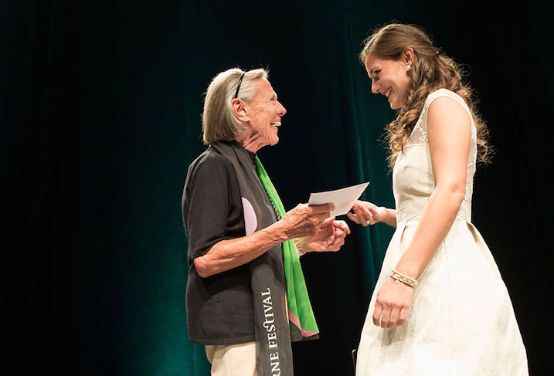
The prizewinners are Jonas Inglin (classical music profile), Laurin Moor (jazz profile) and Noelle Egli (jazz profile).
Trombonist Jonas Inglin from Baar ZG achieved very good grades in all module areas. Together with Christoph Vogt (Bachelor of Arts in Music graduate, classical music profile), he also completed a Bachelor's project entitled "tailor-made". The two students commissioned various works for composition and consequently premiered them. Jonas Inglin is now starting his Master of Arts in Music Education.
Under the title "Konrads kleiner Kurs in Sachen Selbstverzweiflung", double bass player Laurin Moor from Lungern OW has realized a radio play project in which music, text and dance were brought together. Laurin Moor is now continuing his studies in the Master of Music and Art Performance. He is also engaged at the Lucerne Theater, where he is directing "Feeling Gatsby", a co-production with the Lucerne University of Applied Sciences and Arts.
Noelle Egli from Wolhusen LU worked on the joint Bachelor's diploma project "Sechsundfünfzig Prozent" (Fifty-six percent) in the music degree program and also achieved the highest grade A in the pedagogical degree.





